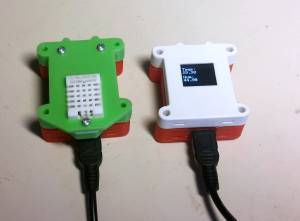DHT ja OLED näidis
Antud näidis demonstreerib kuidas DHT andur on võimeline saatma temperatuuri ja niiskuse näidu OLED ekraanile kasutades selle jaoks ITT IoT raamistikku. Selle näite jaoks on vaja kahte kontrollerit: üht OLED-i ja teist DHT anduri jaoks.
Kui kood on üles laetud, saadab DHT kontroller temperatuuri ja niiskuse näidu läbi mqtt OLED ekraanile.
Kõigepealt tuleb üks moodul tööle saada ning siis jätame selle mooduli tööle, kustutame arvutist selle mooduli koodi ära (soovi korral säilitame word-i vms dokumendis) ning samasse kohta loome teise mooduli koodi.
Järgnev kood on mõeldud sellele kontrollerile, mis on ühendatud DHT anduriga. Vajaminevad teegid:
lib_deps = ITTIoT, DHT sensor library, Adafruit Unified Sensor
Kui pärast programeerimist ilmub andmete asemel ekraanile NAN, tuleb USB kaabel lahti ühendada ning uuesti ühendada!
// Includes global variables and librarys that the DHT uses #include <Arduino.h> #include <ittiot.h> #include <Ticker.h> #include <DHT.h> #define WIFI_NAME "name" #define WIFI_PASSWORD "password" #define DHTPIN D3 // Pin where DHT shield is connected. Change this to D4 if the shield has no legs removed. #define DHTTYPE DHT22 // DHT 22 (AM2302) // Create an object for DHT sensor DHT dht(DHTPIN, DHTTYPE); // Create an object for Ticker library Ticker timeTicker; bool sendDataFlag; // Ticker library callback, which will occur 0.5 second interval. void sendData() { sendDataFlag=true; } // Function started after the connection to the server is established. void iot_connected() { // Send message to serial port to show that connection is established Serial.println("MQTT connected callback"); // Send message to MQTT server to show that connection is established iot.log("IoT DHT example!"); } void setup() { // Initialize serial port and send message Serial.begin(115200); // setting up serial connection parameter Serial.println("Booting"); //iot.setConfig("wname", WIFI_NAME); //iot.setConfig("wpass", WIFI_PASSWORD); iot.printConfig(); // print IoT json config to serial iot.setup(); // Initialize IoT library // Initialize DHT library dht.begin(); // Initialize Ticker interval and callback timeTicker.attach(1, sendData); } void loop() { iot.handle(); // IoT behind the plan work, it should be periodically called if(sendDataFlag) { sendDataFlag = false; // Read humidity and temperature float h = dht.readHumidity(); float t = dht.readTemperature(); // Create a buffer to store strings to being sent later char buf[10]; // Convert temperature value messages to strings and send to the MQTT server String(t).toCharArray(buf,10); iot.publishMsg("temp",buf); // Convert humidity value messages to strings and send to the MQTT server String(h).toCharArray(buf,10); iot.publishMsg("hum",buf); } }
Järgnev kood on mõeldud kontrollerile, mis on ühendatud OLED ekraaniga. Vajaminevad teegid:
lib_deps = ITTIoT, Adafruit GFX Library, Adafruit SSD1306 Wemos Mini OLED, adafruit/Adafruit BusIO
// Includes global variables and librarys that the OLED display uses #include <Arduino.h> #include <ittiot.h> #include <Adafruit_I2CDevice.h> #include <Adafruit_GFX.h> #include <Adafruit_SSD1306.h> #define WIFI_NAME "name" #define WIFI_PASSWORD "password" // Change it according to the real name of the microcontroller where DHT shield is connected #define DHT_TOPIC "ESP30" // OLED reset pin is GPIO0 #define OLED_RESET 0 // Create an object for OLED screen Adafruit_SSD1306 display(OLED_RESET); // Define variables to store humidity and temperature values float h; float t; // Message received void iot_received(String topic, String msg) { // Check if topic contains temperature data if(topic == (DHT_TOPIC"/temp")) { t = msg.toFloat(); // Convert string to float } // Check if topic contains humidity data if(topic == (DHT_TOPIC"/hum")) { h = msg.toFloat(); // Convert string to float } } // Function started after the connection to the server is established. void iot_connected() { // Send message to serial port to show that connection is established Serial.println("MQTT connected callback"); // Subscribe to topics to get temperature and humidity messages iot.subscribe(DHT_TOPIC"/temp"); iot.subscribe(DHT_TOPIC"/hum"); // Send message to MQTT server to show that connection is established iot.log("IoT OLED example!"); } void setup() { // Initialize serial port and send message Serial.begin(115200); // setting up serial connection parameter Serial.println("Booting"); // Initialize OLED with the I2C addr 0x3C (for the 64x48) display.begin(SSD1306_SWITCHCAPVCC, 0x3C); // Display "booting..." message display.clearDisplay(); display.setTextSize(1); display.setTextColor(WHITE); display.setCursor(0,0); display.println("Booting..."); display.display(); //iot.setConfig("wname", WIFI_NAME); //iot.setConfig("wpass", WIFI_PASSWORD); iot.printConfig(); // print IoT json config to serial iot.setup(); // Initialize IoT library } void loop() { iot.handle();// IoT behind the plan work, it should be periodically called // Display temperature and humidity readings to OLED screen display.clearDisplay(); // cleanse the OLED display display.setTextSize(1); // sets the text size display.setTextColor(WHITE); // sets the text color display.setCursor(0,0); // sets the cursor position display.println("Temp: "); // writes text display.println(t); // write temperature value display.setCursor(0,20); display.println("Hum: "); display.println(h); display.display(); delay(200); // Waiting 0.2 second }


